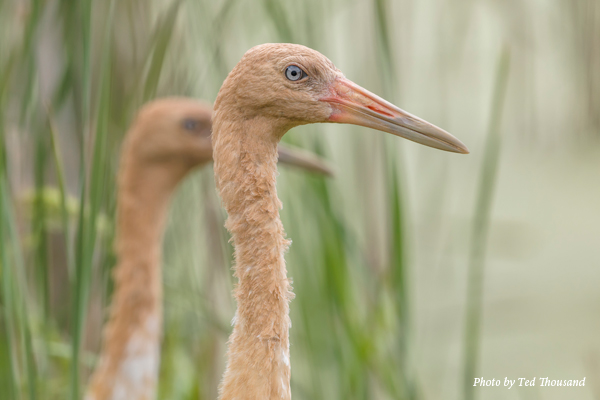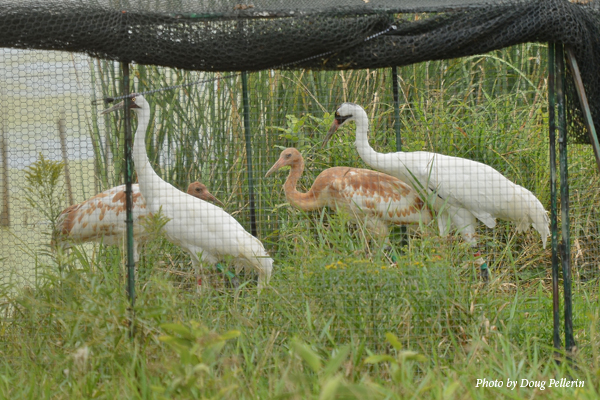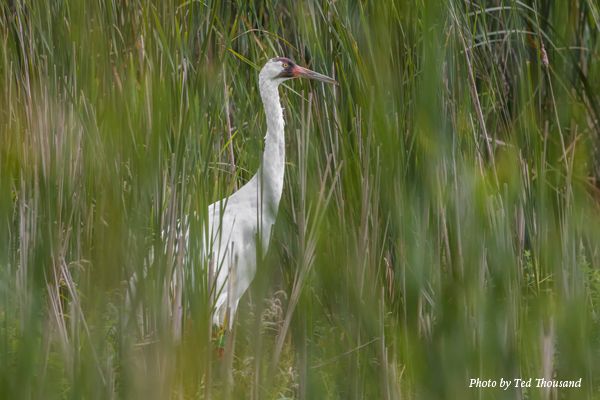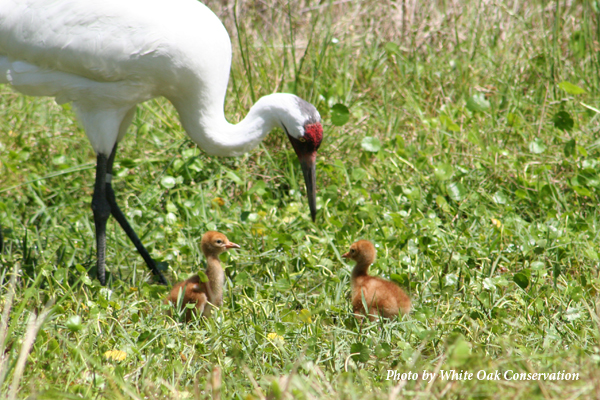
Media contact: Anne Lacy, Crane Research Coordinator, 608-356-9462 ext.146
Baraboo, Wis. – A reintroduction success story took place this past weekend, when a Whooping Crane family returned to Wisconsin, flown North courtesy of Windway Capital Corp. of Sheboygan, Wisconsin.
The family will call the marsh its home until they migrate South on their own again this fall. They will be monitored by the staff of the International Crane Foundation, as part of the Whooping Crane Eastern Partnership (WCEP).

“This story – still ongoing – is really an enormous success for Whooping Cranes, and reintroduction science, due to the experimental nature of this pairing,” said International Crane Foundation Crane Research Coordinator Anne Lacy.
The patriarch of the family has a colorful history. Grasshopper, or 16-11, was raised at the International Crane Foundation through the Direct Autumn Release Program. He was released at Horicon National Wildlife Refuge in 2011.
In 2015, the International Crane Foundation discovered that Grasshopper had paired with a Sandhill Crane female at Horicon National Wildlife Refuge in eastern Wisconsin. “Wisconsin’s current Whooping Crane population is so small, we really didn’t like this pairing. We prefer that he create more Whooping Cranes, of course!” explained Lacy.
This pair had a hybrid chick in the spring of 2016. As this was not in the plans of WCEP, the chick was captured and brought to the International Crane Foundation, where he happily resides today in Crane City.

In hopes of re-pairing Grasshopper with a female whooping crane, he was relocated in the fall of 2016 to White Oak Conservation, a private, accredited facility in Yulee, Florida. There, the partnership undertook a never-before-attempted experiment – trying to create a new pairing and return the new pair back to the wild.
The Partnership choose a more appropriate mate for Grasshopper, a female Whooping Crane named Hemlock, or 18-12. She was costume-reared at The International Crane Foundation, but not released as a chick for health reasons that have now been resolved.
“The plan was to give the pair space in a safe setting to see if they would become a couple,” said Lacy. “If they were successful as a breeding pair, it would be one more step forward in bolstering the wild population.”
As cranes are famous for being very particular in choosing a mate, the WCEP partnership waited with fingers crossed, to observe what would happen after introducing the pair. “Thankfully, it didn’t take long for them to exhibit friendly behaviors,” recalled Lacy. “Within the year they were unison calling together and flying circles around their large enclosure.”

Just as cranes are fussy when it comes to their partners they are renowned for their mate fidelity once they have forged that bond. This spring, their bond was strong enough for Hemlock to lay eggs. “Our expectations were met and then some,” Lacy said. “Not only did Hemlock lay two eggs, they were both fertile.” Thirty days later, the first two Whooping Crane chicks of 2018 hatched.”
This story now continues on the Wisconsin landscape, where researchers hope the family will acclimate to successfully living in the wild.
“The successful release of this crane family is a testament to the commitment and cooperation of the partners involved, resulting in positive outcomes and support for the long-term recovery of the whooping crane,” said Steve Shurter, CEO of White Oak Conservation.
“For an endangered species like the Whooping Crane, every individual – and their ability to reproduce – is critical to the survival of the species,” explained Lacy. “That’s why we go the extra mile to help with their fragile recovery.”
###
About the International Crane Foundation
The International Crane Foundation plays a leading role in the conservation of Whooping Cranes, from managed breeding and release programs to habitat protection, citizen education and engagement, and threat reduction along their flyways. Learn more about the International Crane Foundation and its work to protect Endangered Whooping Cranes at www.savingcranes.org.
About White Oak Conservation
White Oak works to save endangered species and wild places. White Oak leads global conservation through innovative science, education, training and collaborations. We are committed to providing conservation options for many of the species that need them the most. White Oak’s 16,000 riverfront acres in northeast Florida provide a refuge for more than 17 different endangered species. Additionally, White Oak works to help and inspire others to support conservation by hosting education, conservation, corporate and family groups for visits, overnight stays, conferences and meetings. We are an Association of Zoos & Aquariums (AZA) certified facility. White Oak is owned by philanthropists Mark and Kimbra Walter. More information about White Oak is available at www.whiteoakwildlife.org.
About the Whooping Crane Eastern Partnership
The Whooping Crane Eastern Partnership is a group of agencies, non-profit organizations and individuals, formed to restore to eastern North America, a migratory population of Whooping Cranes. More information about the partnership is available at www.bringbackthecranes.org.
